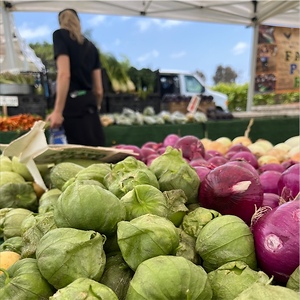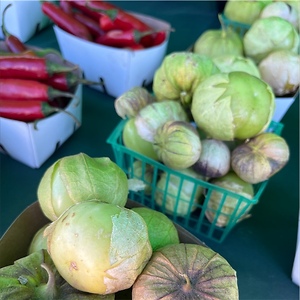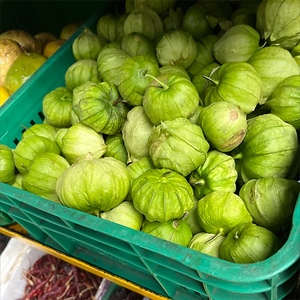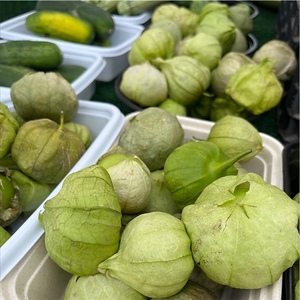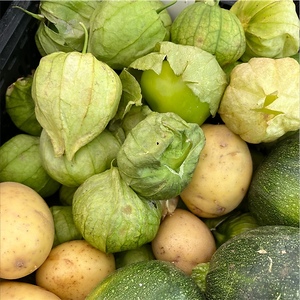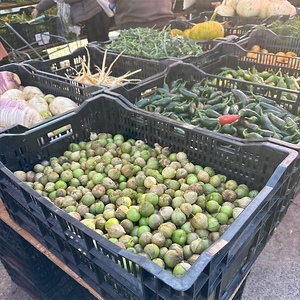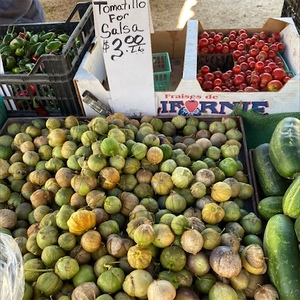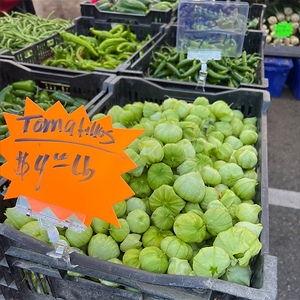

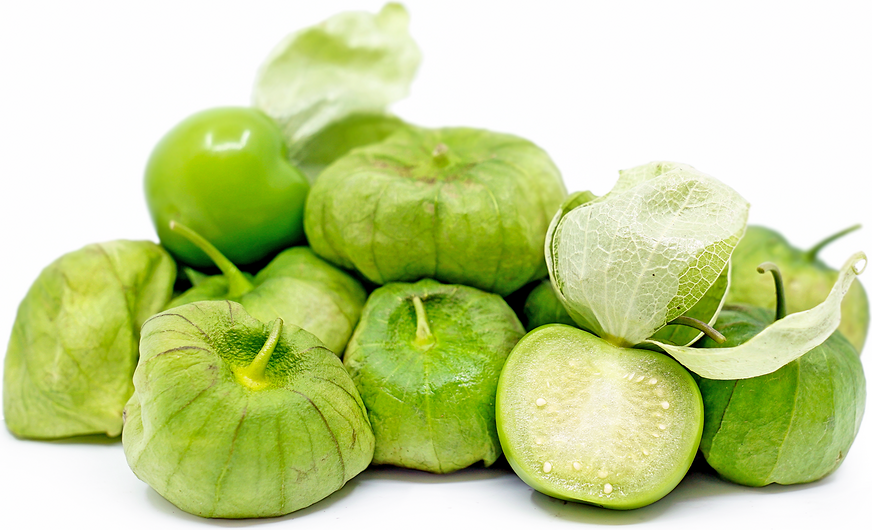
Tomatillos
Estimated Inventory, 38 lbs : 36.67
This item was last sold on : 07/29/25
Description/Taste
Tomatillos are small nightshade fruits shaped like miniature tomatoes. They are low, sprawling plants that reach an average of 1/2 to 1 meter in height and produce high yields of husked fruit, which are often described as looking like Chinese lanterns when they hang on the plant. Tomatillos are covered in a papery, veiny outer skin, or husk, and measure about 5 centimeters in diameter. As the husk begins to dry, it splits open and fades from green to light brown as the fruit matures. The fruit inside the husk is typically bright green, though it can also be yellow or purple, and is covered in a slightly sticky residue that can be easily washed off. Tomatillos have a bright green stem that is somewhat harry and grows oval-shaped toothed leaves. Beneath the glossy skin of the Tomatillo fruit is a dense, cloudy white-green flesh that encases small white seeds. Tomatillos have a fresh, tangy scent with hints of citrus, akin to the smell of limes and green tomatoes. Tomatillos are harvested when the fruits are still immature. They have a tart flavor, much different than their relative the tomato.
Seasons/Availability
In their native Mexico, Tomatillos are available year-round. In the cooler climates of North America, they are available from July to September.
Current Facts
Tomatillos, which translates to “little tomatoes,” are botanically referred to as Physalis philadelphica and like all species in the genus Physalis, are distinguished by their papery outer husk. The Tomatillo is a relative of the tomato, as both are members of the Solanaceae family, also known as the nightshade family. Tomatillos are called green tomatoes, tomato verde, tomates de cascara, tomates de fresadillas, husk tomatoes, and jamberries. They're also referred to as Miltomatl, the original Aztec name that is still used in Oaxaca. Tomatillos are open-pollinated, meaning that their seed will reproduce plants identical to the parent. Planting two or more Tomatillos together may be best for encouraging cross-pollination.
Nutritional Value
Tomatillos are denser in minerals than tomatoes as they are packed with unique phytochemicals and flavonoids. These phytochemicals may help reduce inflammation, inhibit the growth of cancer cells, improve vascular health, and potentially lower the risk of chronic diseases like cancer and heart disease. Tomatillos contain vitamins A, C, and K, which can help with immune function, vision, skin and bone health, collagen production, and blood clotting. These vitamins may also reduce the risk of fractures and decrease the length and severity of colds. Tomatillos have niacin, potassium, manganese, and magnesium. These nutrients help nerve health, fluid balance, muscle contractions, cholesterol and carbohydrate metabolism, reduce inflammation, wound healing, energy production, and blood sugar and blood pressure regulation. Because of their fiber content, Tomatillos may help with digestive health and lowering cholesterol levels. In Mexico, it is believed that a decoction of Tomatillo husks can be used to treat diabetes.
Applications
Tomatillos can be used in similar ways to regular tomatoes, although they offer a slightly more tart flavor and contain less sugar. That tart, slightly acidic taste makes them perfect for eating raw or cooked. They can be incorporated into salsas, sauces, or jams. When used in salsa, Tomatillos tone down the hotness of chilies and help blend the flavors of the different ingredients. They are credited as the source of the "piquant" flavor in authentic Mexican cuisine and are used as the key ingredient for traditional salsa verde, which can be served with enchiladas, quesadillas, and fried chicken. Diced raw Tomatillos add a nice crunch to fresh guacamole and pair well with onions, cilantro, chili peppers, and garlic. When harvested at their more ripe, golden-colored stage, they are often used in stews or simmered with meats for flavoring. To prepare Tomatillos, remove the papery husks, then rinse and dry the fruit. They are typically not seeded before cooking. Store Tomatillos with their husks intact for about three weeks in the refrigerator in a paper bag. To keep them longer, remove the husk, wash the fruit, and freeze them.
Ethnic/Cultural Info
Tomatillos were likely domesticated by the Aztecs of central Mexico around 800 BCE or 900 BCE in the Tehuacán Valley—before tomatoes had ever been cultivated in the region. The Aztecs were also responsible for introducing foods like corn, chilies, and chocolate to the rest of the world. Tomatillos were also important to Mesoamerican tribes like the Mayans and are still considered a staple ingredient in Mexican cuisine, especially for authentic salsa verde. When the Spanish conquests came through Mexico and Central America in the 16th and 17th centuries, Tomatillos were brought back to Spain by the explorers. Though they did not initially catch on there, Tomatillos eventually made their way to India where they were quickly cultivated and incorporated into traditional dishes.
Geography/History
Tomatillos are native to Mexico and Central America, where the Aztecs first cultivated them as early as 800 BC. Like tomatoes, Tomatillos are a warm-season crop and cannot withstand frost. Tomatillos grow wild in Mexico and Central America along roadsides and sunny open fields. They are also grown commercially, particularly in Mexico and Guatemala, and in home gardens. Tomatillos spread beyond their native region when Spanish settlers discovered them and brought them back to Europe, where they eventually traveled to places within the Eastern world. Outside of their native region, Tomatillos became more popular in the United States in the 21st century and are often found in grocery stores, farmers’ markets, and gardens there, as well as in South Africa and Australia.
Featured Restaurants
Restaurants currently purchasing this product as an ingredient for their menu.
| Saint Mark Golf and Resort, LLC | San Marcos CA | 508-320-6644 |
| PFC Fitness Camp | Carlsbad CA | 888-488-8936 |
| The Crack Shack-Encinitas | Encinitas CA | 877-230-1871 |
| Ron Oliver | San Diego | 619-295-3172 |
| Special Order | San Diego CA | 619-876-4070 |
| Shorehouse Kitchen | La Jolla CA | 858-459-3300 |
| Paradise Point Resort Tidal | San Diego CA | 858-490-6363 |
| Artifact at Mingei | San Diego CA | 619-846-2164 |
| Juniper & Ivy | San Diego CA | 858-481-3666 |
| Fernside | San Diego CA | 619-398-5156 |
| Hilton La Jolla Torrey Pines | La Jolla CA | 858-450-4581 |
| Kettner Exchange | San Diego CA | 909-915-9877 |
| WineSellar & Brasserie | San Diego CA | 858-450-9557 |
| The Monsaraz | San Diego CA | 858-760-6228 |
| Piatti | San Diego CA | 858-454-1589 |
| Lilo NA | Carlsbad CA | 619-385-0914 |
| Miguel's Cocina Carlsbad | Carlsbad CA | 760-759-1843 |
| Bound Coffee | Oceanside CA | 760-805-3505 |
| Two Ducks (Deliver Lion Share) | San Diego CA | 619-564-6924 |
| The Crack Shack Costa Mesa | Costa Mesa CA | 951-808-7790 |
| Herb & Sea | Encinitas CA | 858-587-6601 |
| The Kitchen at MCASD | La Jolla CA | 619-880-8719 |
| Third Corner Ocean Beach | San Diego CA | 619-223-2700 |
| Camino Riviera | San Diego CA | 619-685-3881 |
| Communal Coffee | San Diego CA | 619-305-9525 |
| Beaumont's | San Diego CA | 858-459-0474 |
| Fish Guts | San Diego CA | 619-888-0081 |
| The Shout House | San Diego CA | 619-231-6700 |
| Blind Lady | San Diego CA | 619-381-4475 |
| Viejas Casino Grove Steakhouse | Alpine CA | 800-295-3172 |
| Madi | San Diego CA | 320-491-1217 |
| Grass Skirt | San Diego CA | 858-412-5237 |
| Park Hyatt Aviara | Carlsbad CA | 760-448-1234 |
| Milton's Delicatessen, Grill & Bakery | Del Mar CA | 858-792-2225 |
| Pacifica Del Mar | Del Mar CA | 858-792-0505 |
| Le Papagayo (Encinitas) | Encinitas CA | 760-944-8252 |
| Brigantine Imperial Beach | Imperial Beach CA | 619-591-1350 |
| Marriott Gaslamp | San Diego CA | 619-696-0234 x6051 |
| Brigantine Del Mar | Del Mar CA | 858-481-1166 |
| The Besta-Wan Pizza House | Cardiff CA | 805-231-2515 |
| Hash House A Go Go | San Diego CA | 951-764-0605 |
| Born & Raised | San Diego CA | 619-944-1631 |
| Trust Restaurant | San Diego CA | 609-780-7572 |
| Georges at the Cove | San Diego CA | 858-454-4244 |
| Nutmeg Bakery & Cafe 1 | San Diego CA | 858-405-2401 |
| Kairoa Brewing Company | San Diego CA | 858-735-0051 |
| Books and Records | San Diego CA | 619-310-5298 |
| Jeune Et Jolie | Carlsbad CA | 858-231-0862 |
| The Seabird Resort | Oceanside CA | 442-222-9505 |
| Bali Hai Restaurant | San Diego CA | 619-222-1181 |
| Nolita Hall | San Diego CA | 619-618-8820 |
| Carte Hotel | San Diego CA | 619-365-1858 |
| Sbicca Del Mar | Del Mar CA | 619-417-2587 |
| SB Kitchen (Bar) | Solana Beach CA | 610-717-7217 |
| Wayfarer Bread | La Jolla CA | 805-709-0964 |
| Common Theory | San Diego CA | 858-384-7974 |
| Common Theory Chula Vista | Chula Vista CA | 619-495-3689 |
| Maderas Golf Club | Poway CA | 858-451-8100 |
| Mitch's Seafood | San Diego CA | 619-316-7314 |
| Lilo | Carlsbad CA | 619-385-0914 |
| Junkyard Sports Bar and Grill | Oceanside CA | 760-407-8500 |
| Bernardo Heights Country Club | San Diego CA | 858-487-4022 |
| Green Dragon Tavern & Museum | Carlsbad CA | 760-797-5579 |
| Brigantine Pt Loma | San Diego CA | 619-224-2871 |
| The Country Club Of Rancho Bernardo | San Diego CA | 858-487-1134 |
| Rancho Santa Fe Golf Club | Rancho Santa Fe CA | 858-756-1582 |
| Palmys | San Diego CA | 858-886-7111 |
| Fox Point Farms | Encinitas CA | 619-892-0553 |
| Marriott Courtyard - Broadway | San Diego CA | 619-446-3008 |
| Gravity Heights Restaurant and Brewery | San Diego CA | 858-551-5105 |
| Chef Drew Mc Partlin | San Diego CA | 619-990-9201 |
| Inn at Rancho Santa Fe (Banquet) | Rancho Santa Fe CA | 858-381-8289 |
| Brigantine Escondido | Escondido CA | 760-743-4718 |
| The Cottage Encinitas | Encinitas CA | 858-454-8409 |
| Fresco Cocina | Carlsbad CA | 760-720-3737 |
| 619 Spirits | San Diego CA | 509-701-9534 |
| UnaMas on Adams | San Diego CA | |
| Institutes of Health LLC | San Diego CA | 800-270-5016 |
| Rosewood Social | San Juan Capistrano CA | 669-243-8403 |
| The Crack Shack-San Diego | San Diego CA | 619-795-3299 |
| Hotel La Jolla - Sea & Sky | La Jolla CA | 858-459-0261 |
| Single Fin Surf Grill | San Diego CA | 619-948-7873 |
| Lodge at Torrey Pines Grill | San Diego CA | 858-453-4420 |
| Local Tap House & Kitchen | Oceanside CA | 760-547-1469 |
| Gold Finch | San Diego CA | 619-804-2051 |
| Cantina Mayahuel | San Diego CA | 619-283-6292 |
| Viewpoint Brewing Co. | Del Mar CA | 858-205-9835 |
| Haven | San Diego CA | 619-928-2086 |
| Barbarella La Jolla | La Jolla CA | 858-454-7373 |
| Prey Brewing Company | Vista CA | 760-822-4226 |
| The Roxy Encinitas | Encinitas CA | 760-230-2899 |
| Communal Coffee - Oceanside | Oceanside CA | 619-920-7887 |
| The Cottage Del Mar | Del Mar CA | 858-775-1197 |
| Asti Ristorante | San Diego CA | 619-232-8844 |
| Fishery | San Diego CA | 858-272-9985 |
| The Switchboard Restaurant 2024 | Oceanside CA | 760-279-6300 |
| The Lion Share | San Diego CA | 619-564-6924 |
| Storyhouse Spirits Bar | San Diego CA | 801-949-5955 |
| Morning Glory | San Diego CA | 619-629-0302 |
| The Glen at Scripps Ranch | San Diego CA | 858-444-8500 |
| Jake's Del Mar | Del Mar CA | 858-755-2002 |
| Fay's Diner and Cafe | San Diego CA | 661-858-8895 |
| Cal A Vie | Vista CA | 760-945-2055 |
| Brockton Villa Restaurant | San Diego CA | 858-454-7393 |
| Crest Cafe | San Diego CA | 619-295-2510 |
| 31ThirtyOne by Deckman | San Diego CA | 619-495-9814 |
| Polaris Supreme | San Diego CA | 619-390-7890 |
| The Santaluz Club Inc - Main Dining | San Diego CA | 858-759-3150 |
| US Grant Hotel Main | San Diego CA | 619-232-3121 |
| The Tavern | Coronado CA | 602-628-5890 |
| SD Continuing Education Culinary Arts | San Diego CA | 619-719-6924 |
| The Flavor Chef (Catering) | Vista CA | 619-295-3172 |
| Nomad Donuts | San Diego CA | 619-431-5000 |
| Chateau La Jolla | San Diego CA | 858-459-4451 |
| Harvest Kitchen | Vista CA | 619-709-0938 |
| Oscars Brewing Company | Temecula CA | 619-695-2422 |
| Leu Leu | Leucadia CA | 619-316-5807 |
| The Pearl Hotel | San Diego CA | 877-732-7573 |
| Mission Ave Bar and Grill | Oceanside CA | 760-717-5899 |
| Rosemary Trattoria | Coronado CA | 619-669-8435 |
| Pretty Pickled, Pretty Sauced | National City CA | 619-869-9921 |
| The Mission MB | San Diego CA | 858-488-9060 |
| The Lion Share 2025 | San Diego CA | 619-564-6924 |
| Ketch Grill and Taps | San Diego CA | 858-268-1030 |
| La Dona | San Diego CA | 858-352-8134 |
| The Mission EV | San Diego CA | 619-232-7662 |
| Sabor a Vida Café & Deli | Vista CA | 760-536-3331 |
| J & Tonys | San Diego CA | 855-634-7664 |
| The Santaluz Club Inc - Banquet | San Diego CA | 858-759-3150 |
| Lodge at Torrey Pines Main | San Diego CA | 858-453-4420 |
| Hawaiian Fresh Seafood | San Diego CA | 858-299-8862 |
| University Club | San Diego CA | 619-234-5200 |
| Tahona (Kitchen) | San Diego CA | 619-573-0289 |
| Wormwood | San Diego CA | 619-573-0289 |
| Animae | San Diego CA | 619-925-7908 |
| InterContinental Vistal Kitchen | San Diego CA | 619-501-9400 |
| Dot Cafe | San Diego CA | 914-263-1424 |
| Waverly | Cardiff CA | 619-244-0416 |
| Order Fire Barbecue | Santee CA | 619-768-3986 |
| Hawaiian Fresh Seafood - Poway | Poway CA | 858-299-8862 |
| Kona Kai Resort and Marina | San Diego CA | 619-221-8000 |
| Hilton Mission Valley | San Diego CA | 619-543-9000 |
| Monarch School (Nutrition Lab) | San Diego CA | 619-804-1766 |
| Hotel Republic San Diego | San Diego CA | 951-756-9357 |
| Comma | San Diego CA | 619-802-9183 |
| Mission+Garnet | San Diego CA | 858-361-0870 |
| Bridges at Rancho Santa Fe | Rancho Santa Fe CA | 858-759-6063 |
| Carolines Seaside Cafe | La Jolla CA | 619-646-1481 |
| Q&A Oyster Bar & Restaurant | Oceanside CA | 858-245-3780 |
| Casa | San Diego CA | 619-581-3003 |
| Southwestern Yacht Club | San Diego CA | 619-222-0438 |
| Belching Beaver Brewery - Pub 980 | Vista CA | 760-420-7764 |
| San Diego Yacht Club | San Diego CA | 619-758-6334 |
| Something Homemade | Vista CA | 858-245-1004 |
| Miguel's Old Town | San Diego CA | 619-298-9840 |
| Brigantine Coronado | Coronado CA | 619-435-4166 |
| Coya Peruvian Secret | Del Mar CA | 619-295-3172 |
| The Shores | La Jolla CA | 858-459-8271 |
| Deeply Nourished | La Jolla CA | 808-489-7366 |
| Miho | San Diego CA | 619-365-5655 |
| Hasta Manana Cantina | San Diego CA | 619-276-6700 |
| Reata Glen | Ladera Ranch CA | 949-545-2250 |
| The Lab Restaurant | Oceanside CA | 619-861-8299 |
| Nobu | San Diego CA | 619-814-4124 |
| Shogun Sportfishing | San Diego CA | 619-226-8030 |
| UCSD Health East campus | San Diego CA | 619-578-3373 |
| Nectarine Grove | Encinitas CA | 760-944-4525 |
| DoubleTree By Hilton San Diego | San Diego CA | 619-881-6900 |
| The Cottage La Jolla | La Jolla CA | 858-454-8408 |
| Sugar Bear Enterprises | San Diego CA | 925-383-3623 |
| Pure Meal Prep SD | San Diego CA | 209-485-4861 |
| Crudo Cevicheria & Oyster Bar | San Diego CA | 619-313-9127 |
| Brigantine Poway | Poway CA | 858-486-3066 |
| Fort Oak | San Diego CA | 619-795-6901 |
| Estancia Adobe | San Diego CA | 858-550-1000 |
| Rancho Valencia | Del Mar CA | 858-756-1123 |
| Azuki Sushi Lounge | San Diego CA | 619-238-4760 |
| Tap Room Beer Co. | San Diego CA | 619-539-7738 |
| Home & Away - Old Town | San Diego CA | 619-886-1358 |
| Gravity Heights Mission Valley | San Diego CA | 619-384-5993 |
| Humphrey's | San Diego CA | 619-224-3577 |
| Frenchy's Hideout | San Diego CA | 858-345-7379 |
| C 2 C | San Diego CA | 619-972-9345 |
| Comedor Nishi | La Jolla CA | 619-549-9919 |
| The Beau Hotel | San Diego CA | 619-310-5160 |
| Coast Catering | Escondido CA | 619-295-3173 |
| Side Bar | San Diego CA | 619-348-6138 |
| Campfire | Carlsbad CA | 760-637-5121 |
| The Crack Shack PB | San Diego CA | 619-450-7978 |
| Manna | Encinitas CA | 510-366-3057 |
| Urban Kitchen Catering | San Diego CA | 619-276-8803 |
| Salt and Lime | Del Mar CA | 858-926-8582 |
| Brigantine La Mesa | La Mesa CA | 619-465-1935 |
| The Promiscuous Fork-La Jolla Blvd | La Jolla CA | 858-776-3246 |
| Common Stock | San Diego CA | 619-310-5298 |
| Belching Beaver Brewery Tavern and Grill | Vista CA | 760-509-4424 |
| Firefly Beach | San Diego CA | 619-222-6440 |
| Lil Piggy's | Coronado CA | 619-522-6890 |
| Knotty Barrel- Rancho | San Diego CA | 858-484-8758 |
| Nectarine Grove Bakehouse | Del Mar CA | 858-925-7357 |
| The Mission NP | San Diego CA | 619-220-8992 |
| Finca North Park | San Diego CA | 619-581-3003 |
| La Costa Resort & Spa Main Kitchen | Carlsbad CA | 760-930-7063 |
| Culinary Kitchen Catering and Events | Coronado CA | 619-798-8477 |
| Maxota Raw | San Diego CA | 201-615-1727 |
| Rabbit Hole | San Diego CA | 619-255-4653 |
| LANA | Solana Beach CA | 602-758-2596 |
| Davanti Enoteca Little Italy | San Diego CA | 619-237-9606 |
| Portside Pier (Ketch Tasting Deck) | San Diego CA | 858-268-1030 |
| Top of the Market | San Diego CA | 619-234-4867 |
| Herb & Wood | San Diego CA | 520-205-1288 |
| Chocolate Bar | Carlsbad CA | 442-500-2007 |
| Mission Pacific | Oceanside CA | 760-450-7864 |
| Valley View Casino & Hotel (Black&Blue) | Valley Center CA | 760-291-5500 |
| Mavericks Beach Club | San Diego CA | 858-999-0348 |
| Trattoria I Trulli | Encinitas CA | 760-277-9826 |
| Communal Coffee LLC - Bankers Hill | San Diego CA | 619-920-7887 |
| Alejandra's Cocina | Carlsbad CA | 858-500-5075 |
| Sheraton Carlsbad (Banquets) | Carlsbad CA | 760-827-2400 |
| Pamplemousse Grill | Solana Beach CA | 858-792-9090 |
| The Guild Hotel | San Diego CA | 619-764-5108 |
| Solana Beach Kitchen | Solana Beach CA | 610-717-7217 |
| Boujiemana | San Diego CA | 415-710-0510 |
| Shore Rider | La Jolla CA | 858-412-5308 |
| InterContinental San Diego | San Diego CA | 619-501-9400 |
Recipe Ideas
Recipes that include Tomatillos. One



